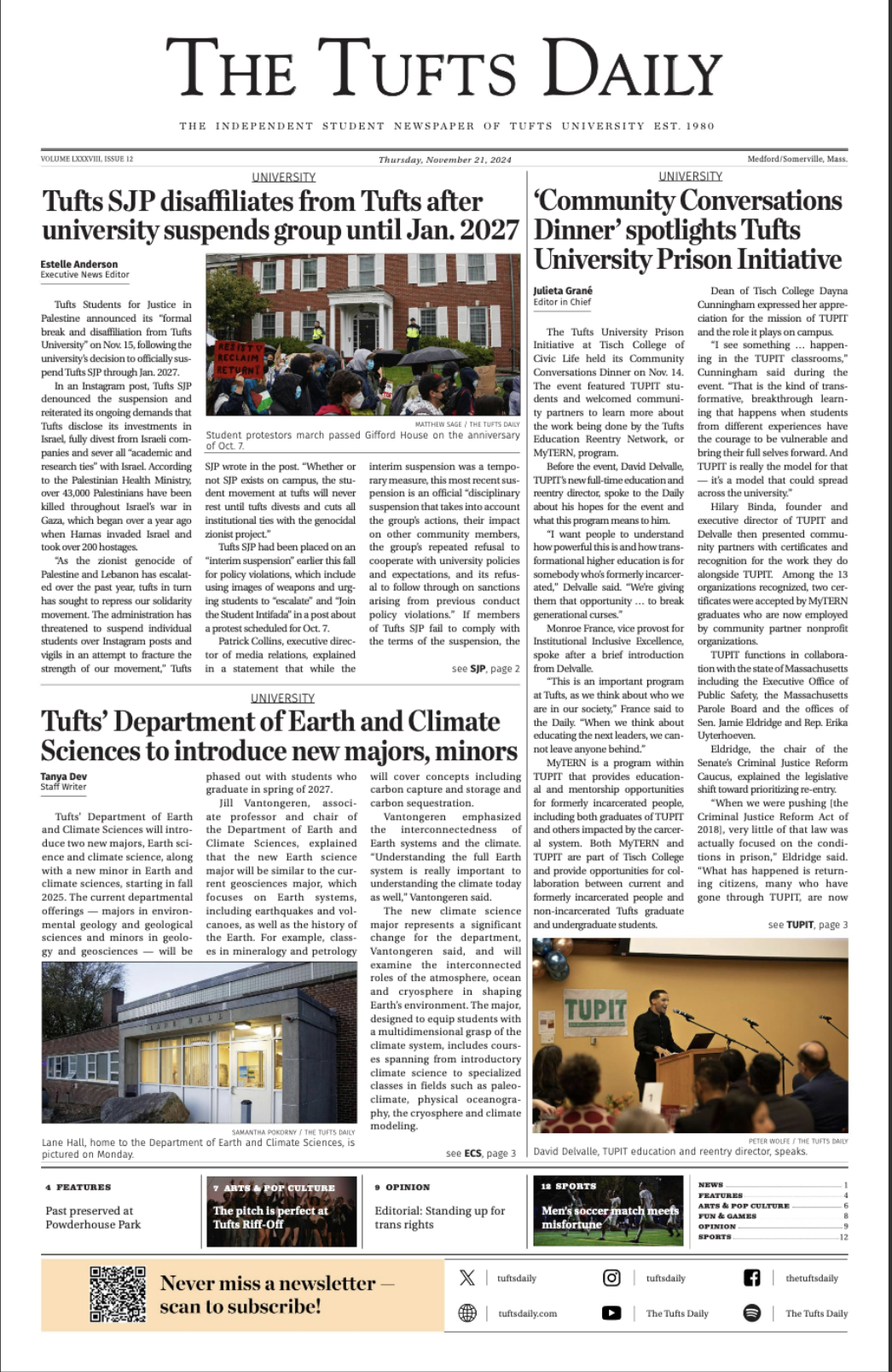Most students on Tufts campus are aware that when they cross the street, they’re likely to get honked at and perhaps experience a near miss with a speeding car. At intersections throughout Medford and Somerville and across our campus, including one of the busiest intersections, the Boston Avenue and College Avenue crossing between the Memorial Steps and the Science and Engineering Complex (SEC), cars are running red lights, cutting each other off and zooming in an effort to slip through a yellow light.
Throughout the day students find themselves maneuvering through the chaos with difficulty. Simply walking to class, and especially walking at night, can be dangerous. That’s not to say the drivers are always in the wrong; there are a good number of students crossing the street while glued to phones, immersed in music or simply jaywalking. That said, there are many attentive, law-abiding students that still nearly get hit by cars as they cross the street, despite Massachusetts law and the National Uniform Vehicle Code stating that pedestrians have the right of way in marked crosswalks. While pedestrians must be cautious, cars are machines much more dangerous than feet, and drivers bear the heaviest burden when it comes to road safety.
Notorious for hazards are the Boston Avenue and College Avenue intersection and the stretch of College Avenue running from Professors Row to Boston Avenue, where there are designated crosswalks marked with crossing signals as well as a crosswalk with no crossing signal. Students going to classes in the SEC must navigate a maze of other students and cars that refuse to yield to pedestrians, and students on bicycles run the risk of not being noticed in the busy traffic. This is an incredibly common experience at Tufts, as students who spoke to the Daily attested.
Senior Erica Nork recalls how she was nearly hit while biking during the summer as she was turning on to Boston Avenue. Nork, riding on the opposite side of the street of the bike lane, was signaling to turn, and as she was turning, she was almost struck by a car.
“I screamed out loud, swerved into the other direction and into the sidewalk, and basically crashed my bike,” Nork said. “Some people just drive so fast, and [Boston Avenue is] so narrow.” It was an experience that proved just how dangerous the road can be.
Another student, first-year Danielle Shaw, also spoke to the Daily.
“I feel that a lot of the times when I’m crossing the street, people slow down like right in front of the crosswalk rather than slowing down for a while, so I don’t know if they’re going to stop,” Shaw said. “It’s a little more stressful than if they were just going to be more cautious and slow the whole time.”
So what’s the solution here? Our proposal is a simple one: placing radar speed signs on Boston Avenue and College Avenue so that drivers are made aware of their speed. There’s already a radar speed sign between the Powder House rotary and Packard Avenue, which was installed in order to maintain slower speeds and calm traffic. Boston Avenue is in need of the same measures.
According to a survey of 2000 drivers conducted by insurance comparison company Zebra, 25% of drivers feel compelled to respond to work-related messages while driving and many other factors beyond texting contribute to distracted and unsafe driving, which endangers both drivers and pedestrians. Dynamic speed monitoring displays, or radar speed signs, have been shown to be effective in managing traffic speeds, and the interactivity of the sign has been shown to be an important factor in limiting speeds. Simply providing people with information about their actions in real time, even if that information is redundant, can cause people to change and improve their behavior. This is called a feedback loop and is a simple and effective concept that can be implemented to encourage better habits.
These reminders of awareness for drivers on campus are relatively low-cost and simple ways to mitigate the chaos of our roadways, especially those frequently crossed by large groups of students. Tufts should request and advocate for the installation of radar speed signs around campus, especially on busy streets like Boston Avenue and College Avenue. Medford, Somerville and the Massachusetts Department of Transportation should be willing and eager to help, as road safety is in everyone's best interest.
Editorial: Install radar speed signs on College Avenue and Boston Avenue






